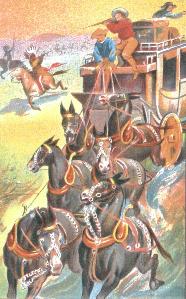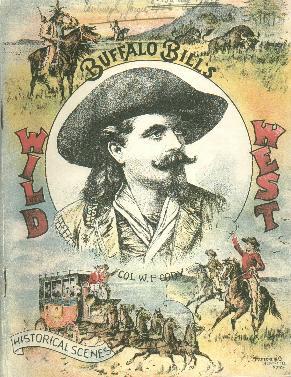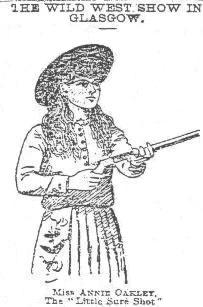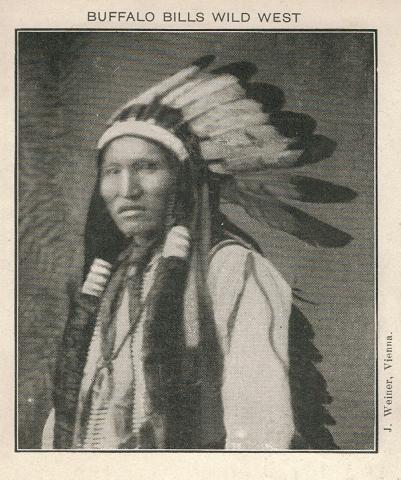

| Home Links Contact |
| 1887-88 1891-92 1892 1902-03 1904 |
|
|

“None but the Brave Deserve the Fair.” (Scene - Room in a public-house, near Bridgeton Cross. Time - Saturday night. Dramatis personae - Two working men.)
First - Hae ye been tae the Wild West Show yet, Tam?
Tam - Na, man, a’ve nae great thocht of gaun ether. The wife’s feared I wid com’ hame scalpit.
First - Auch; thur’s nae fear o’ that. The injuns are as tame as rabbits. D’ye ken a saw yin o’ thum in his full war pent, blanket an’ a’, airm an’ airm, in Duke Street, the ither nicht, efter the performance, wi’ as bonnie a white lassie as ever ye clappit e’en on. Ay, she wis a regular beauty; dressed up tae the nines tae, wi’ her yellow hair hingin’ frae below a nate wee hat. Man a’ just fare envied the redskin.
The Bailie for Wednesday, December 9th, 1891
Buffalo Bill at Ibrox On the occasion of Buffalo Bill’s Wild West’s first visit to Scotland, Glasgow was the sole venue. A residency originally intended to run for six weeks but which eventually ran to fifteen was secured by the lease of the recently vacated East End Exhibition Buildings in Dennistoun, specially converted into a 7,000 seater amphitheatre. Having completed a week’s engagement in Croydon, near London, on Saturday, 24th October 1891, the company headed north by train, arriving in Glasgow on Monday, 26th; Buffalo Bill himself followed a week or so later. The opening night finally took place on Monday, 16th November 1891, after a succession of ‘vexatious delays’ had forced repeated postponements, whilst an army of workmen battled round the clock with the extensive preparations. The run would finally conclude on Saturday, 27th February 1892.
The spectacle causing such a sensation in the city that winter was entitled The Drama of Civilization. By means of a series of tableaux grouped into six dramatic episodes, it presented a highly culturally biased interpretation of the manner in which ‘civility’ had supposedly triumphed over the primordial chaos of paganism and lawlessness over the course of several centuries of American history.
1891-92 British venues, full listing
The front cover of
the programme for
Season 1891-92
It goes without saying that the Indians were vilified as the villains of the piece, and that the near destruction of their culture was represented not merely as an unfortunate side-effect but as the crowning glory in the triumphant and inexorable outcome of the process of cultural evolution. Included in the programme were Indian attacks on a wagon train, a ranch, and the Deadwood stage. On each occasion, Buffalo Bill and his scouts and cowboys would ride to the rescue, scattering the ‘Redskins’ in confusion. The essential themes of later Hollywood mythology were already in place.
Cowboys demonstrated feats of horsemanship - already well established as enduring elements in the Wild West’s brand of entertainment - picking up objects from the ground while riding at a gallop, the throwing of the lasso, and the riding of bucking broncos.
Highly innovative special effects were used to great effect, simulating a prairie fire and a cyclone. There was even a small herd of buffalo.

Exhibitions of markmanship were given by Buffalo Bill himself, C.L. Daly the pistol and revolver expert, Johnny Baker, and best of all, the Wild West’s ever-popular star attraction, Miss Annie Oakley, seen here in a line drawing from the Evening Times, 9th November 1891.
An unpardonable piece of historical revisionism provided the undoubted high point of the entertainment. This came with a re-enactment of the Battle of the Little Bighorn, billed in the programme as The fall of brave General Custer and his entire command. The famous Indian victory was almost inexplicably presented as an ‘ambush’ by the Indians, without any indication within the context of the show that the Indians were the victims of an unprovoked campaign of aggression. What Kicking Bear must have made of it we can only imagine. He had distinguished himself in the initial (Reno) phase of the battle, killing a number of the retreating troopers in the river. Certain eye witnesses later went on record as testifying that he had fired the decisive shot of the entire engagement, firing the shot which splattered Arikara scout Bloody Knife’s blood and brains all over Major Reno, thus precipitating a general panic which ended in rout. Whether or not Kicking Bear next proceeded to Last Stand Hill remains uncertain. Short Bull’s status as a bona fide Little Bighorn veteran is unclear and complicated by the involvement of an Oglala warrior of the same name. Kicking Bear and Short Bull, therefore, both numbered amongst the seventeen remaining Fort Sheridan hostages who made it as far as Glasgow, out of an original complement of twenty-three; six had previously been sent home, suffering from ill health.
Enduring local myths continue to insist that Sitting Bull, Wild Bill Hickok and even the Apache leader Geronimo came to Glasgow at this time but these claims can conclusively be attributed to people letting their imaginations run away with them. The first two had certainly associated with Cody during earlier phases of his show business career but Hickok had been shot dead during a card game in Deadwood in 1876 and Sitting Bull had been assassinated by Standing Rock reservation police in December 1890.

A decade and a half later, a postcard recalling Kicking Bear’s time with the show was published. The photograph upon which it was based had been taken during 1891-92 by the Dennistoun Photographic Co., of 40, Belgrove Street, Glasgow.
Predictably, the 1891-92 sojourn proved highly eventful and the principal incidents are now outlined on a month-by-month basis:
1891 November December 1892 January February March